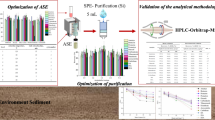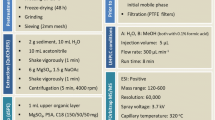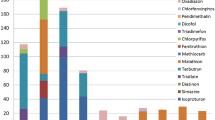Abstract
Using several extraction methods including the QuEChERS approach, samples of both model and natural sediments were prepared. For the isolation of the target group of pesticides, two variants of two complementary extractions had to be used. Resulting extracts were analysed with LC/MS/MS. Selected methods furnishing the best results were validated in the terms of linearity and repeatability. Their limits of detection ranged from 0.1 to 2 ng/g, their limits of quantification from 1 to 6 ng/g and their recovery percentage varied between 46 % and 102 %.
Similar content being viewed by others
References
Anastassiades M, Lehotay SJ, Stajnbaher D, Schenck F (2003) Fast and easy multiresidue method employing acetonitrile extraction/partitioning and “disperzive solid-phase extraction“for the determination of pesticide residues in produce. J Assoc Off Ana Chem Int 86:412–431
Botitsi HV, Garbis SD, Economou A, Tsipi DF (2011) Current mass spectrometry strategies for the analysis of pesticides and their metabolites in food and water matrices. Mass Spectrom Rev 30:907–939
Brondi SHG, de Macedo AN, Vicente GHL, Nogueira ARA (2011) Evaluation of the QuEChERS method and gas-chromatography-mass spectrometry for the analysis pesticide residues in water and sediments. Bull Environ Contam Toxicol 86:18–22
Cunha SC, Fernandes JO, Alves A, Oliveira MBPP (2009) Fast low-pressure gas chromatography–mass spectrometry method for the determination of multiple pesticides in grapes, musts and wines. J Chromatogr A 1216:119–126
Diez C, Traag WA, Zommer P, Marinero P, Atienza J (2006) Comparison of an acetonitrile extraction/partitioning and “dispersive solid-extraction”method” with classical multi-residue methods for the extraction of herbicide residues in barley samples. J Chromatogr A 1131:11–23
Hiemstra M, de Kok A (2007) Comprehensive multi-residue method for the target analysis of pesticides in crops using liquid chromatography-tandem mass spectrometry. J Chromatogr A 1154:3–25
Hustert K, Moza PN, Kettrup A (1999) Photochemical degradation of carboxin and oxycarboxin in the presence of humic substances and soil. Chemosphere 38:3423–3429
Koesukwiwat U, Lehotay SJ, Miao S, Leepipatpiboon N (2010) High throughput analysis of 150 pesticides in fruits and vegetables using QuEChERS and low-pressure gas chromatography–time-of-flight mass spectrometry. J Chromatogr A 1217:6692–6703
Lehotay SJ, de Kok A, Hiemstra M, van Bodegraven P (2005) Validation of fast and easy method for the determination of residues from 229 pesticides in fruit and vegetables using gas and liquid chromatography and mass spectrometric detection. J Assoc Off Ana Chem Int 88:595–614
Lesueur C, Gartner M, Mentler A, Fuerhacker M (2008) Comparison of four extraction methods for the analysis of 24 pesticides in soil samples with gas chromatography-mass spectrometry and liquid chromatography-ion trap-mass spectrometry. Talanta 75:284–293
Luke MA, Forberg JE, Masumoto H (1975) Extraction and cleanup of organochlorine, organophosphate, organonitrogen and hydrocarbon pesticides in produce for determination by gas-liquid chromatography. J Assoc Off Ana Chem Int 58:1020–1026
Pizzuti IR, de Kok A, Hiemstra M, Wickert C, Prestes OD (2007) Method validation and comparison of acetonitrile and acetone extraction for the analysis of 169 pesticides in soya grain by liquid chromatography-tandem mass spectrometry. J Chromatogr A 1142:123–136
Romero-González R, Frenich AG, Vidal JLM, Prestes OD, Grio SL (2011) Simultaneous determination of pesticides, biopesticides and mycotoxins in organic products applying a quick, easy, cheap, effective, rugged and safe extraction procedure and ultra-high performance liquid chromatography–tandem mass spectrometry. J Chromatogr A 1218:1477–1485
Rosales-Conrado N (2009) Hydrolysis study and extraction of spiroxamine from soils of different physico-chemical properties. Chemosphere 77:821–828
Suchánek M, Plzák Z, Šubrt P, Koruna I (1997) Kvalimetrie (Qualimetry), vol 7. Validace analytických metod (Validation of analytical methods), EURACHEM-ČR, Praha
Acknowledgments
This work was funded by the research project of the Ministry of Environment MZP0002071101 “Research and protection of hydrosphere research and relationship and processes in water component of the environment focused on impact of human pressures, the sustainable use and protection of the hydrosphere and legislative tools“.
Author information
Authors and Affiliations
Corresponding author
Rights and permissions
About this article
Cite this article
Kvíčalová, M., Doubravová, P., Jobánek, R. et al. Application of Different Extraction Methods for the Determination of Selected Pesticide Residues in Sediments. Bull Environ Contam Toxicol 89, 21–26 (2012). https://doi.org/10.1007/s00128-012-0622-y
Received:
Accepted:
Published:
Issue Date:
DOI: https://doi.org/10.1007/s00128-012-0622-y




